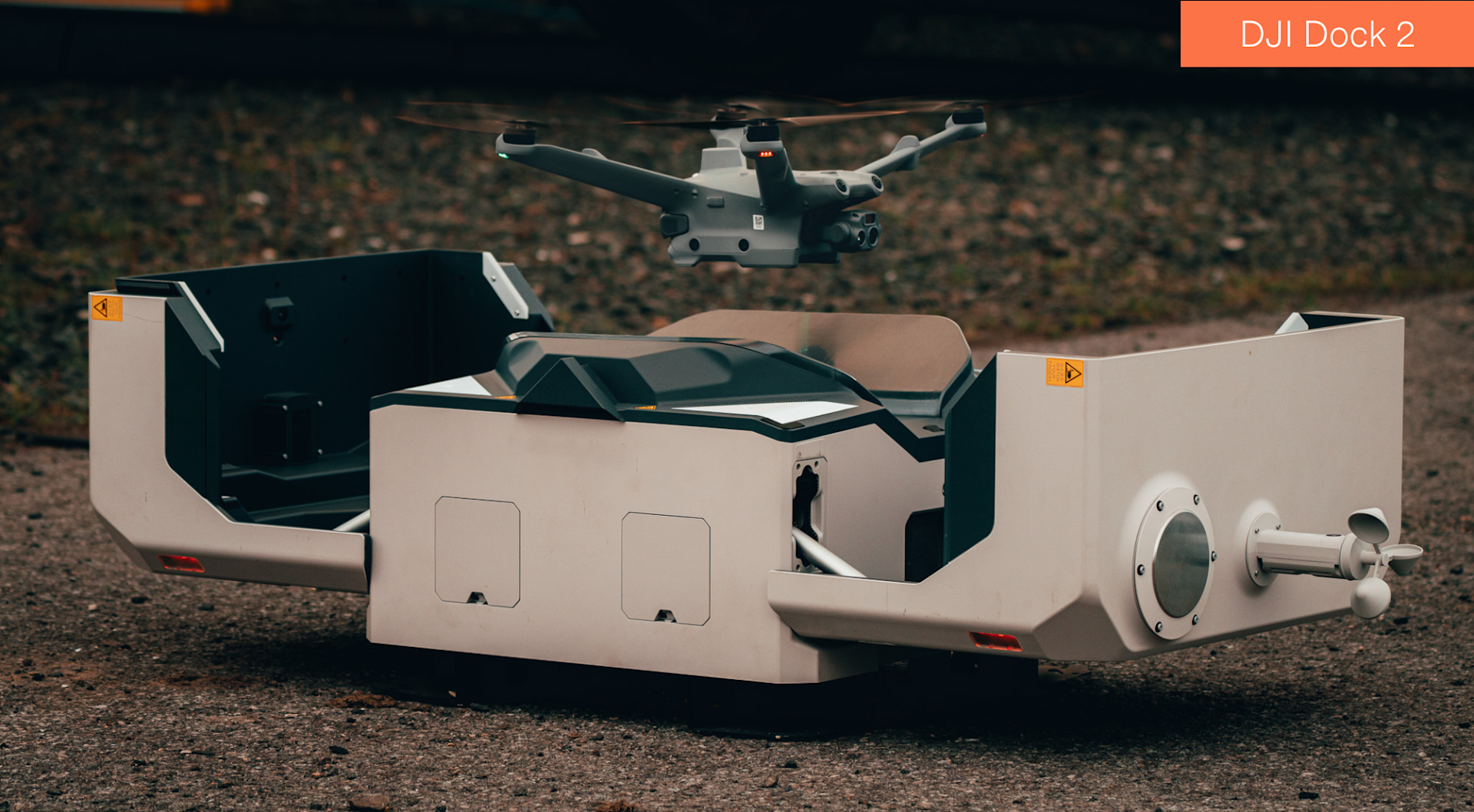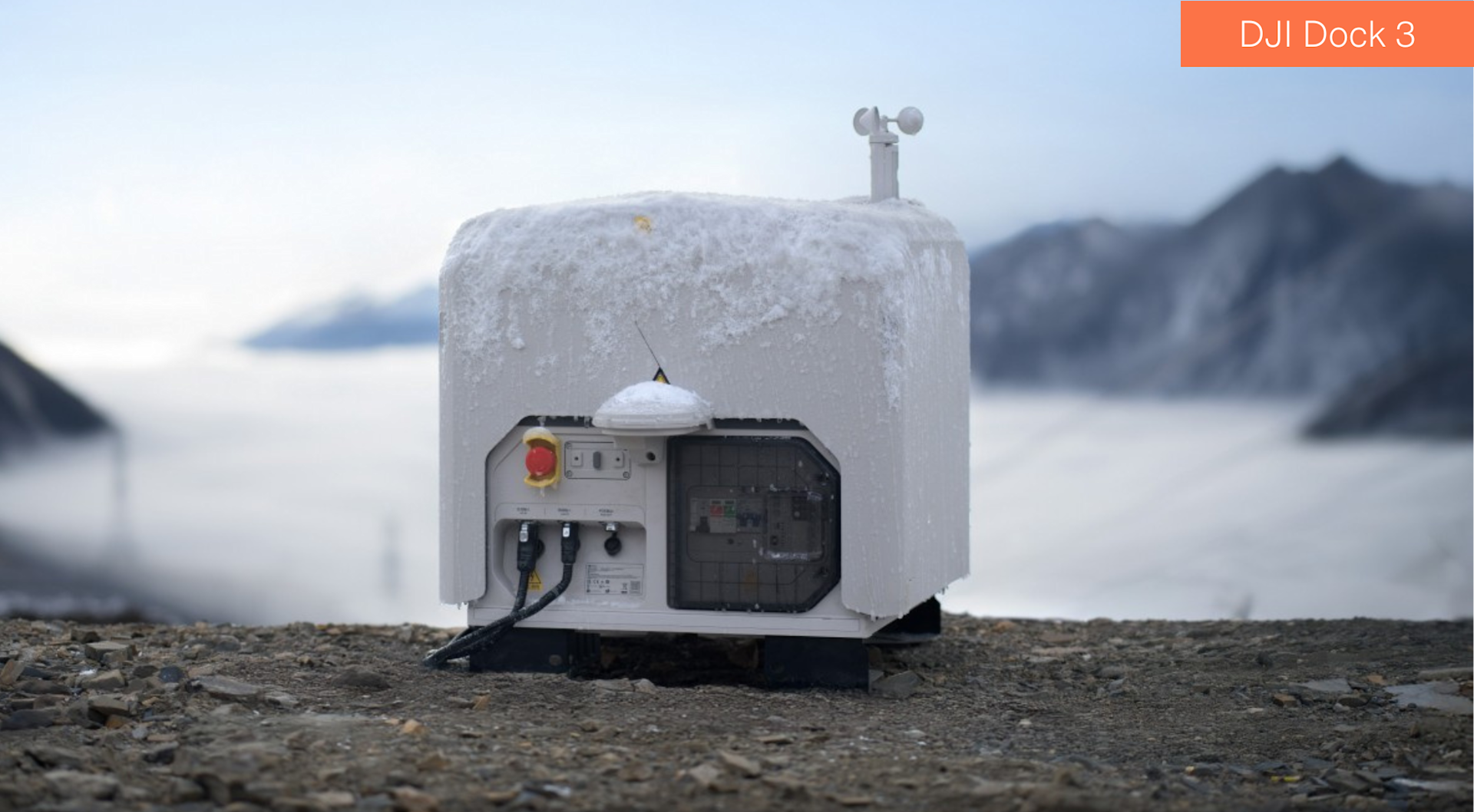
Products
DJI Dock 3 vs DJI Dock 2
In-depth comparison showcasing the differences between DJI Dock 3 and DJI Dock 2.
Comparison between DJI Dock 3 and DJI Dock 2;
Dock 3 has key upgrades, including enhanced weather protection, increased flight time, more intelligent features, and optimised support for vehicle mounting;
heliguy™ is a trusted DJI Dock partner and can help organisations integrate Dock solutions into their workflows.
The drone-in-a-box evolution is in full swing - and DJI has just released its latest iteration: Dock 3.

This new Dock on the block ushers in an exciting chapter for remote and automated drone solutions, packing some stellar features, including the ability to be deployed from a vehicle. It is compatible with the powerful DJI Matrice 4D Series, which can utilise an additional LiDAR module for object detection.
It offers some tangible upgrades and benefits compared to the DJI Dock 2, which was launched globally in March 2024.

This blog explores the key differences between the two Docks, and showcases some of the enhancements of Dock 3.
And if you're keen to integrate Dock 3 into your workflows, contact heliguy™ - a trusted DJI Dock partner with an integrated internal support infrastructure to enable you to start and scale drone-in-a-box operations.
Key Specs At A Glance
This table provides an overview of the key differences between DJI Dock 3 and DJI Dock 2.
Environmental Adaptability
DJI Dock 3 | DJI Dock 2 | |
|---|---|---|
IP Rating | Dock: IP56 Drones (DJI M4D/M4TD): IP55 | Dock: IP55 Drones (DJI M3D/M3TD): IP54 |
Wind Resistance | 12m/s (Operation and landing) | 12m/s (Operation); 8m/s (landing) |
Max Deployable Altitude | 4500m | 4000m |
Operating Temperature | Dock: -30°C to 50°C Drones: -20°C to 50°C | Dock: -25°C to 45°C (when the ambient temperature is below -20°C the Dock is in stand-by status and the drone can't perform flight tasks) Drones: -20°C to 45°C |
Design
DJI Dock 3 | DJI Dock 2 | |
|---|---|---|
Total Weight | 55kg | 34kg |
Dimensions - Cover Opened | 1760 x 745 x 485 mm | 1228 x 583 x 412 mm |
Dimensions - Cover Closed | 640 x 745 x 770 mm | 570 x 583 x 465 mm |
Deployment Conditions
DJI Dock 3 | DJI Dock 2 | |
|---|---|---|
Vehicle Deployment | Supported | Not supported |
Single-side High-rise Obstruction | Supported | Not supported |
Tower Deployment | Supported | Not supported |
Drone Flight Capability
DJI Dock 3 (DJI M4D/M4TD) | DJI Dock 2 (DJI M3D/M3TD) | |
|---|---|---|
Max Flight Time | 54 minutes | 50 minutes |
Max Hover Time | 47 minutes | 40 minutes |
Return to Home Battery | 15% | 25% |
Charging Time | 27 minutes: 15%-95% | 32 minutes: 20%-90% |
Video Transmission | DJI O4+ Enterprise 12km (CE) | DJI O3 Enterprise 8km (CE) |
Max Download Speed | 20 MB/s (with DJI Dock 3) 20 MB/s (with DJI RC Plus 2 Enterprise) | 5 MB/s (with DJI Dock 2) 15 MB/s (with DJI RC Pro Enterprise) |
Camera Payload
DJI Dock 3 (DJI M4D/M4TD) | DJI Dock 2 (DJI M3D/M3TD) | |
|---|---|---|
Visible Light Lens | 1x, 3x, 7x | 1x, 7x |
Infrared | M4TD only: 640 x 512, Super Resolution 1280 x 1024 | M3TD only: 640 x 512, Super Resolution 1280 x 1024 |
Laser Rangefinder | Supported | Not supported |
NIR Auxiliary Light | Supported (M4TD only) | Not supported |
Night Scene Mode | Supported | Not supported |
Max Hybrid Zoom | 112x | 56x |
Features
DJI Dock 3 | DJI Dock 2 | |
|---|---|---|
Smart People, Vehicle, Boat Detection | Supported | Not supported |
Smart Track | Supported | Not supported |
Intelligent Auto Route | Supported | Not supported |
Smart 3D Capture | Supported (M4D only) | Not supported |
Next-gen Smart Oblique | Supported (M4D only) | Not supported |
Supported Software
DJI Dock 3 | DJI Dock 2 | |
|---|---|---|
Applications | DJI Enterprise app (used with Android phones for deployment and commissioning) | |
Cloud Platform | FlightHub 2 FlightHub 2 On-Premises Version FlightHub 2 FlightHub Sync DJI Cloud API | DJI FlightHub 2 (supported by default) Third-party cloud platforms (accessed through DJI Cloud API) |
Accessories
DJI Dock 3 | DJI Dock 2 | |
|---|---|---|
D-RTK 3 Relay Fixed Version | Supported | Not supported |
DJI Spotlight and Speaker | Available | Not available |
Obstacle Sensing Module | Available | Not available |
DJI Dock 3 vs DJI Dock 2: In-detail Comparison
The tables above provide an overview of the differences between DJI Dock 3 and DJI Dock 2. Now, we'll dive deeper into the key upgrades of DJI Dock 3.
Weather Resistance
Drone-in-a-box systems are designed for on-demand deployments, so their ability to handle the elements is a key factor.
DJI Dock 2 was a hardy solution, but DJI Dock 3 ups the ante to provide a more rugged drone-in-a-box solution.
The Dock 3's IP rating has been increased to IP56, compared to Dock 2's IP55, while the drones also offer greater protection against the elements, including the addition of anti-icing propellers.
Dock 3 also features a more powerful air-conditioning system, and its cover can open when covered with 10mm of icing. As such, Dock 3's operational envelope has been expanded, with the ability to handle temperatures ranging from -30°C to 50°C.

One of the stand-out features is the Dock 3's ability to enable 12m/s wind speeds at take-off and landing, as well as during operation. In contrast, the Dock 2's M3D and M3TD drones can handle 12m/s during flight, but are limited to 8m/s at landing and take-off, which can hinder some deployment scenarios.
Flexible Deployments
One of the highlights of DJI Dock 3 is its ability to be deployed in a range of different ways - including mobile deployment.
Indeed, Dock 3 is DJI's first drone-in-a-box that supports vehicle mounting. And for higher efficiency, two docks can be simultaneously deployed on a single vehicle for dual-drone rotations.

While Dock 2 was touted as a mobile option, the Dock 3 is optimised for this type of operation: The internal components, such as the air conditioning system and back-up battery, have an anti-vibration design, while a vehicle-mounted gimbal mount (available separately) prevents damage during vehicle transportation.
Furthermore, when utilising DJI FlightHub 2, Dock 3 supports remote RTK calibration and horizontal angle detection (which prevents take-off when the angle is greater than 5°.
The Dock 3 also supports a rapid 10-second takeoff, with real-time data transmission during flight.
On top of this, the Matrice 4D Series can be used with the DJI RC Plus 2 Enterprise smart controller for innovative onboard relay: Allowing one drone to fly high as a relay, extending the operational range of another drone - even without 4G signal, or in obstructed conditions.
The Dock 3's enhanced mobile capability is perfect for scenarios such as drone as a first responder, flexible asset inspection, and multi-site construction monitoring.
However, the Dock 3 can also be deployed as a fixed solution. And it can be paired with the D-RTK 3 Relay Fixed Deployment accessory which ensures rapid connection in challenging environments and can relay transmission signals over buildings and obstacles between the aircraft and the Dock. This can be connected to the 3rd port on Dock 3. It is not compatible with Dock 2.

Dock 3 vs Dock 2: The Drones
So, the Dock itself has been upgraded, but what about the drones that are deployed from it?
Dock 3 can house either the DJI Matrice 4D or the DJI Matrice 4TD - and these platforms bring numerous upgrades compared to the Dock 2's DJI Matrice 3D and Matrice 3TD.

These enhancements include longer flight time - 54 minutes vs 50 minutes; greater operational envelope - IP55 vs IP54; and a quicker in-dock charging time - 27 minutes vs 32 minutes.
The DJI Matrice 4D Series also brings some noticeable improvements in camera capabilities. This includes:
Tele Camera: Pixel quality increased by 4x on M4D Series and zoom capability increased by 2 times.
DJI Matrice 4D Series has a Tele Camera and a Mid-Tele Camera for a smoother zooming experience, compared to M3D Series' Tele Camera.
The DJI Matrice 4D and 4TD feature Night Scene mode.
M4D Series has a laser rangefinder with 1,800m range.
M4TD features an auxiliary light with 100m distance.
The table below provides a breakdown of the key camera specs between the drones.
DJI Matrice 4D | DJI Matrice 3D | DJI Matrice 4TD | DJI Matrice 3TD | |
|---|---|---|---|---|
Wide Angle Camera | 4/3 CMOS, 20 MP Includes Night Scene Mode | 4/3 CMOS, 20 MP | 1/1.3-inch CMOS, 48 MP Includes Night Scene Mode | 1/1.32-inch CMOS, 48 MP |
Tele Camera | 1/1.5-inch CMOS, 48MP Includes Night Scene Mode | 1/2-inch CMOS, 12 MP | 1/1.5-inch CMOS, 48MP Includes Night Scene Mode | 1/2-inch CMOS, 12 MP |
Medium Tele Camera | 1/1.3-inch CMOS, 48 MP Includes Night Scene Mode | - | 1/1.3-inch CMOS, 48 MP Includes Night Scene Mode | - |
Digital Zoom | Tele Camera: 16x (112x hybrid zoom) | Tele Camera: 8x (56x hybrid zoom) | Tele Camera: 16x (112x hybrid zoom) | Tele Camera: 8x (56x hybrid zoom) |
Laser Rangefinder | 1800m range | - | 1800m range | - |
NIR Auxiliary Light | - | - | FOV: 5.7°±0.3° | - |
Thermal Sensor | - | - | Up to 1280 x 1024 @ 30fps video resolution | Up to 1280 x 1024 @ 30fps video resolution |
In terms of deployment scenarios, the DJI M4D and M3D are engineered for precision surveying. They both feature a 4/3 CMOS wide-angle camera with a mechanical shutter, although the M4D has a 0.5 shooting interval compared to the M3D's 0.7s shooting interval.
Meanwhile, the DJI M4TD and M3TD are suited to public safety and inspection - thanks to the addition of the thermal sensor. But, the M4TD's auxiliary light and laser rangefinder enhance capabilities in these mission scenarios.
Accessories
DJI Dock 3 is compatible with a swathe of accessories to enhance operations.
We've already mentioned the D-RTK 3 Relay Fixed Deployment module - which extends the transmission distance and provides an accurate RTK signal to the M4D for high-accuracy positioning - but there's more.

The DJI Matrice 4D and 4TD drones are compatible with an Obstacle Sensing Module: A LiDAR accessory for horizontal and upwards obstacle avoidance. Pair this with the millimeter-wave radar that is built in to the bottom of the aircraft for downward obstacle avoidance, and you have a safety solution that provides omnidirectional obstacle avoidance. This is useful for navigating tight and complex spaces, like sub-stations.

Dock 3's DJI M4D Series can also be integrated with the DJI AL1 Spotlight and DJI AS1 Speaker - compatible with the DJI Matrice 4 Series.
Currently, Dock 2's drones can be deployed with Sniffer4D's Nano2 gas detection solutions. It remains to be seen if this compatibility will be extended to Dock 3's platforms.
DJI Dock 3 vs DJI Dock 2: Summary
DJI Dock 2 was a solid addition to the market, but DJI Dock 3 takes things further.
In many ways, Dock 3 is a hybrid of the last iteration and the original DJI Dock - taking the mobility of Dock 2 (and improving upon this) and packing in some of the original Dock's better weather-proofing.
Dock 3 represents DJI's continued commitment to the drone-in-a-box market and is yet another innovative step forward in this field.
heliguy™ is a DJI Dock partner, with regulatory specialists, training instructors, in-house surveying team, repair centre - including accredited Dock technicians - and solutions engineers, and we have experience of helping organisations start, scale, and integrate Dock technology. To find out how we can help you, contact us.
